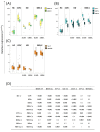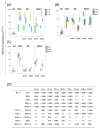Preliminary Evidence of the Differential Expression of Human Endogenous Retroviruses in Kawasaki Disease and SARS-CoV-2-Associated Multisystem Inflammatory Syndrome in Children
- PMID: 37894766
- PMCID: PMC10606856
- DOI: 10.3390/ijms242015086
Preliminary Evidence of the Differential Expression of Human Endogenous Retroviruses in Kawasaki Disease and SARS-CoV-2-Associated Multisystem Inflammatory Syndrome in Children
Abstract
Multisystem inflammatory syndrome in children (MIS-C) is a postinfectious sequela of severe acute respiratory syndrome coronavirus 2 (SARS-CoV-2), with some clinical features overlapping with Kawasaki disease (KD). Our research group and others have highlighted that the spike protein of SARS-CoV-2 can trigger the activation of human endogenous retroviruses (HERVs), which in turn induces inflammatory and immune reactions, suggesting HERVs as contributing factors in COVID-19 immunopathology. With the aim to identify new factors involved in the processes underlying KD and MIS-C, we analysed the transcriptional levels of HERVs, HERV-related genes, and immune mediators in children during the acute and subacute phases compared with COVID-19 paediatric patients and healthy controls. The results showed higher levels of HERV-W, HERV-K, Syn-1, and ASCT-1/2 in KD, MIS-C, and COV patients, while higher levels of Syn-2 and MFSD2A were found only in MIS-C patients. Moreover, KD and MIS-C shared the dysregulation of several inflammatory and regulatory cytokines. Interestingly, in MIS-C patients, negative correlations have been found between HERV-W and IL-10 and between Syn-2 and IL-10, while positive correlations have been found between HERV-K and IL-10. In addition, HERV-W expression positively correlated with the C-reactive protein. This pilot study supports the role of HERVs in inflammatory diseases, suggesting their interplay with the immune system in this setting. The elevated expression of Syn-2 and MFSD2A seems to be a distinctive trait of MIS-C patients, allowing to distinguish them from KD ones. The understanding of pathological mechanisms can lead to the best available treatment for these two diseases, limiting complications and serious outcomes.
Keywords: COVID-19; HERVs; Kawasaki disease; human endogenous retroviruses; inflammation; multisystem inflammatory syndrome in children.
Conflict of interest statement
The authors declare that there are no conflict of interest.
Figures



References
-
- McCrindle B.W., Rowley A.H., Newburger J.W., Burns J.C., Bolger A.F., Gewitz M., Baker A.L., Jackson M.A., Takahashi M., Shah P.B., et al. Diagnosis, Treatment, and Long-Term Management of Kawasaki Disease: A Scientific Statement for Health Professionals From the American Heart Association. Circulation. 2017;135:e927–e999. doi: 10.1161/CIR.0000000000000484. - DOI - PubMed
-
- Rodó X., Curcoll R., Robinson M., Ballester J., Burns J.C., Cayan D.R., Lipkin W.I., Williams B.L., Couto-Rodriguez M., Nakamura Y., et al. Tropospheric winds from northeastern China carry the etiologic agent of Kawasaki disease from its source to Japan. Proc. Natl. Acad. Sci. USA. 2014;111:7952–7957. doi: 10.1073/pnas.1400380111. - DOI - PMC - PubMed
MeSH terms
Substances
Supplementary concepts
LinkOut - more resources
Full Text Sources
Medical
Research Materials
Miscellaneous

